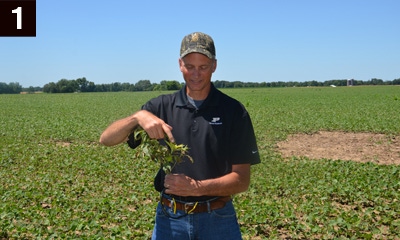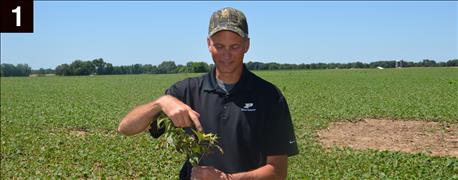
Maybe you think if you’ve seen one soybean field, you’ve seen them all. Bill Johnson, Purdue University Extension weed control specialist, believes you can learn something walking in one field that you might not find in another field.
Come along and see six things Johnson pointed out on a walk through a soybean field earlier this summer. Walking one now would be tougher, but there would still be things to learn.

1. Learn when a weed is injured but will likely recover.
A giant ragweed of good size that is still partially alive several days after herbicide application is probably going to survive, Johnson says. Some weeds show considerable yellowing on leaves after spraying, but then still recover and survive. Obviously, the large giant ragweed pictured below was affected by herbicide, but it isn’t dead. Johnson points to the yellowing of an upper leaf, a common symptom in some ragweed today.
2. Learn to recognize signs of regrowth in weeds.
Look in the heart of the weed, especially with a weed like giant ragweed, Johnson says. If new growth is coming out, even if it is yellow, it’s a good sign the plant is going to survive. Come back later and you could expect to find considerable new growth on the plant. In this photo, the tender shoots in the center of the plant are regrowing.
.jpg?width=300&auto=webp&quality=80&disable=upscale)
3. Learn to gauge weed pressure by looking at field edges.
How well did the herbicide work here? Johnson says it apparently handled very strong giant ragweed pressure well. Note how thick giant ragweed plants are at the edge of the field. While they may not have been that numerous across the entire field, it’s an indication of what was here before the herbicide application, he says.
.jpg?width=300&auto=webp&quality=80&disable=upscale)
4. Learn why weeds may have escaped.
The key may be knowing what type of tillage was done in the field. In this field, conventional tillage was performed before planting. A relatively large lambsquarters plant was likely not completely rooted out by tillage, and was too large for herbicides to control. Note the thin roots that apparently helped this weed survive tillage and hang on.

5. Learn why volunteer corn is still standing.
The herbicides applied in this field apparently weren’t good at controlling volunteer corn. If glyphosate was the main ingredient intended to control grasses, the corn might be glyphosate-resistant, Johnson notes. He advises determining if there is enough volunteer corn to require adding another herbicide good at controlling it. In this field, there were only a few scattered volunteer corn plants — not enough to justify additional herbicide.

6. Learn to take note of what you don’t see.
Scouts had identified Palmer amaranth in this part of the field in a previous season. Johnson didn’t find any on his recent walk through the field. Obviously the herbicide program is helping control it. Sometimes what you don’t see is also important, he concludes.

About the Author(s)
You May Also Like




